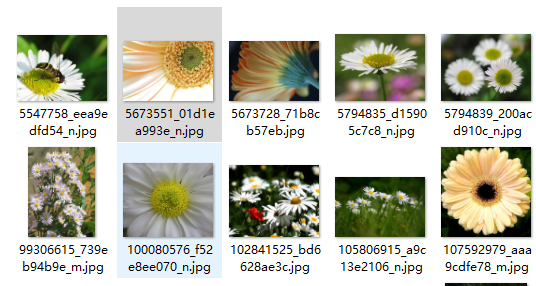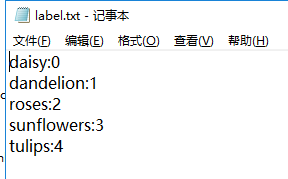本文试图解决一个问题,即我们自定义的数据如何训练模型?初识深度学习,我们接触手写数字识别模型,但是批次数据是mnist已经定义好的,我们现在有自己的图片如何做成批次进行训练模型。
现在我们将准备好的原始数据放在flower_photos下的文件夹下面,里面又分类包含五种花,文件夹的名字即为类名,每种文件夹下面又有若干图片,如下图所示:

例如,daisy文件下面图片,图片的尺寸大小不一致,这在后期要处理。

数据增强
数据增强通过对图片进行一定的处理,使得训练数据量增强,防止过拟合等,这块后期完善。。
由于模型需要既定尺寸大小的图片,我们先对图片进行resize,以下代码将实现对图片调整尺寸后保存在新的地址中。本文只是解决了在一个文件下
def resize_image(base_dir, new_dir, wight, height): if not os.path.exists(new_dir): os.mkdir(new_dir) foldername = os.listdir(base_dir) for folder in foldername: if not os.path.exists(new_dir+'\'+folder): os.mkdir(new_dir+'\'+folder) imagename = os.listdir(base_dir+'\'+folder) for img in imagename: image = Image.open(base_dir +"\"+ folder+'\'+img) image_sized = image.resize((wight, height),Image.ANTIALIAS) image_sized.save(new_dir +"\"+ folder+'\'+img) print('--------------Data_resized DONE-------------------')
write_tfrecord
这里需要一个将类标对应成0,1,2。。的数字,建立一个label.txt,文件夹为类名,对应相应的数字。

本节理论后期完善,下面代码将会生成xx.tfrecord
def convert2example(img_dir, label): image=Image.open(img_dir) width, height = image.size if image.mode != 'RGB': image=image.convert('RGB') image_data=image.tobytes() #img_name1 = bytes(img_name, 'utf-8') example = tf.train.Example(features=tf.train.Features(feature={ 'image/encoded': tf.train.Feature(bytes_list=tf.train.BytesList(value=[image_data])), 'image/height': tf.train.Feature(int64_list=tf.train.Int64List(value=[height])), 'image/width': tf.train.Feature(int64_list=tf.train.Int64List(value=[width])), 'image/label': tf.train.Feature(int64_list=tf.train.Int64List(value=[label])) })) return example def writer_tfrecord(data_dir, label_txt_dir, output_dir, dataset): if not tf.gfile.Exists(output_dir): tf.gfile.MakeDirs(output_dir) out_file=os.path.join(output_dir, dataset+'.tfrecord') num_samples=0 with tf.python_io.TFRecordWriter(out_file) as tfWriter: label_dict = {} with open(label_txt_dir,'r') as f: for line in f.readlines(): folder = line.strip().split(':')[0] label = line.strip().split(':')[1] label_dict[folder] = label image_list, label_list = [], [] for folder in os.listdir(data_dir): dir_path = os.path.join(data_dir,folder,'*.jpg') for image in glob.glob(dir_path): image_list.append(image) label_list.append(int(label_dict[folder])) label = int(label_dict[folder]) example=convert2example(image, label) tfWriter.write(example.SerializeToString()) num_samples+=1 print("Number of samples: {}".format(num_samples))
Get_batch
首先read_tfrecord读取上文生成的tfrecord文件,之后shuffle生成batch,test文件是测试的,
def read_tfrecord(filename_queue): feature = {'image/encoded': tf.FixedLenFeature([], tf.string), 'image/height': tf.FixedLenFeature([], tf.int64), 'image/width': tf.FixedLenFeature([], tf.int64), 'image/label': tf.FixedLenFeature([], tf.int64)} reader = tf.TFRecordReader() _, serialized_example = reader.read(filename_queue) features = tf.parse_single_example(serialized_example, features=feature) image = tf.decode_raw(features['image/encoded'], tf.uint8) image = tf.cast(image, tf.float32) height = tf.cast(features['image/height'],tf.int32) width = tf.cast(features['image/width'], tf.int32) label = tf.cast(features['image/label'], tf.int32) img = tf.reshape(image, [height, width, 3]) # preprocess # subtract mean valu rgb_mean=np.array([123.68, 116.779, 103.939]) img = tf.subtract(img, rgb_mean) # red, green, blue = tf.split(3, 3, img) # img = tf.concat(3, [ # tf.subtract(red , bgr_mean[2]), # tf.subtract(green , bgr_mean[1]), # tf.subtract(blue , bgr_mean[0]), # ]) # center_crop img = tf.image.resize_images(img, [256, 256]) j = int(round((256 - 224) / 2.)) i = int(round((256 - 224) / 2.)) img = img[j:j+224, i:i+224, :] # scale to 1 img = tf.cast(img, tf.float32) * 0.017 return img, label def get_batch(infile, batch_size, num_threads=4, shuffle=False, min_after_dequeue=None): # 使用batch,img的shape必须是静态常量 image, label = read_tfrecord(infile) if min_after_dequeue is None: min_after_dequeue = batch_size * 10 capacity = min_after_dequeue + 3 * batch_size if shuffle: img_batch, label_batch = tf.train.shuffle_batch([image, label], batch_size=batch_size, capacity=capacity,num_threads=num_threads, min_after_dequeue=min_after_dequeue) else: img_batch, label_batch = tf.train.batch([image, label], batch_size, capacity=capacity, num_threads=num_threads, allow_smaller_final_batch=True) return img_batch, label_batch def test_tfrecord(dataset_dir,batch_size): glob_pattern = os.path.join(dataset_dir, '*.tfrecord') tfrecords_list = glob.glob(glob_pattern) filename_queue = tf.train.string_input_producer(tfrecords_list, num_epochs=None) img_batch, label_batch = get_batch(filename_queue, batch_size) print('-----img_batch:------',type(img_batch)) print('-----label_batch:------',type(label_batch))
main 测试
通过下面的代码我们测试下数据。
生成的batch为tensor,这为后期placeholder占位符送入的数据非tensor,需要转换成列表或者其他都可以,有两种方式:
with tf.Session() as sess: print('-----img_batch:------',type(img_batch)) print('-----label_batch:------',type(label_batch))
#第一种 tensor在run后变成array #img_batch, label_batch = sess.run([img_batch, label_batch])
# 第二种,eval()方法可以将tensor变为array
# 同里,将array变为tensor可以用convert_to_tensor() img_batch = img_batch.eval() label_batch = label_batch.eval() print('-----img_batch:------',type(img_batch)) print('-----label_batch:------',type(label_batch))
def main(): label_txt_dir = 'label.txt' data_dir = './resized_flower_photos' base_dir = './flower_photos' new_dir = './resized_flower_photos' resize_wight = 224 resize_height = 224 output_dir = './tfrecord' dataset = 'mobilenetv2_data' #resize_image(base_dir,new_dir,resize_wight,resize_height) #image_list, label_list = read_file(label_txt_dir,data_dir) #writer_tfrecord(data_dir, label_txt_dir, output_dir, dataset) img_batch, label_batch = test_tfrecord(output_dir,64) with tf.Session() as sess: print('-----img_batch:------',type(img_batch)) print('-----label_batch:------',type(label_batch)) img_batch, label_batch = sess.run([img_batch, label_batch]) print('-----img_batch:------',type(img_batch)) print('-----label_batch:------',type(label_batch)) if __name__ == '__main__': main()
创建txt文件
我们需要将图片和类标对应起来作为一个txt文件存在,下面的代码实现了将文件中的内容做成txt文件,这个可以在caffe中的imagedata中使用,需要的数据label_txt_dir如下图:

import tensorflow as tf import os import glob def creat_txt(label_txt_dir, data_dir,txt_name): #将label_txt中的内容放在字典中 label_dict = {} with open(label_txt_dir,'r') as f: for line in f.readlines(): folder = line.strip().split(':')[0] label = line.strip().split(':')[1] label_dict[folder] = label #将文件中的数据放在列表中 image_list, label_list = [], [] for folder in os.listdir(data_dir): dir_path = os.path.join(data_dir,folder,'*.jpg') for image in glob.glob(dir_path): image_list.append(image) label_list.append(label_dict[folder]) #将列表中内容写在文件中 with open(txt_name,'w') as file: for i in range(len(image_list)): file.write(image_list[i]) file.write(' ') file.write(label_list[i]) file.write(' ') file.close() print("There are %d data" % (len(image_list))) print('-------creat_%s Done--------'% txt_name) #------------执行main函数-------------------# def main(): print('----------main-------------') data_dir = './resized_image' label_txt_dir = 'label.txt' txt_name = 'train.txt' creat_txt(label_txt_dir, data_dir,txt_name) if __name__ == '__main__': main()
生成的train.txt文件如下图所示:
